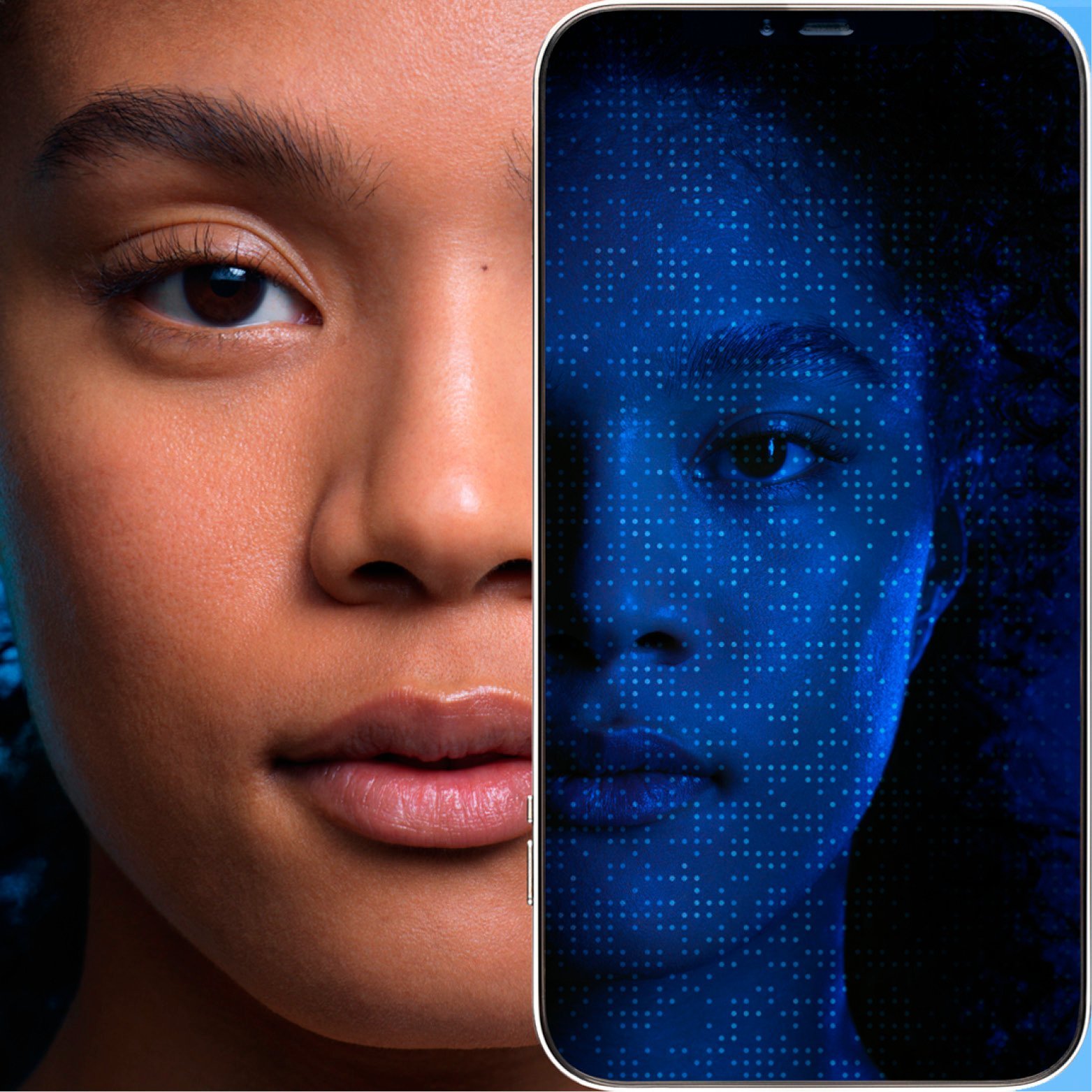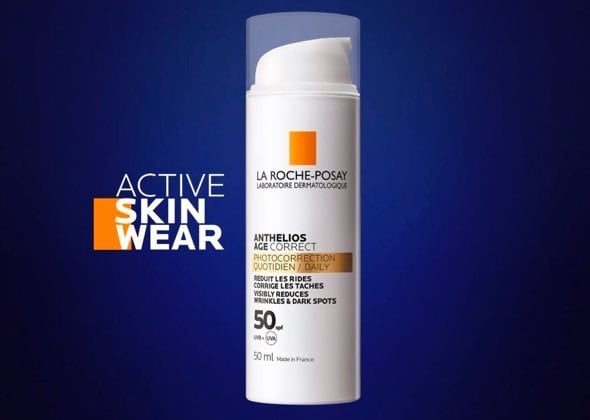SUN: BENEFICIAL
IN SMALL DOSES
Brief sun exposure boosts mood and vitamin D levels
The sun is essential to life. In small doses, it has a beneficial effect on:
- Mood: The sun can be an excellent remedy for certain forms of seasonal depression.
- Vitamin D synthesis, which is indispensable to fix calcium in our bones. To enjoy these benefits, 15 minutes of sun exposure per day suffice.
In strong doses, however, the sun can also be dangerous. Read on to discover the short-term and long-term impact the sun can have from sunburn, sun allergies and acne to premature skin ageing and an increased risk of skin cancer.
SHORT-TERM EFFECTS
OF SUN EXPOSURE
Sunburn
UV rays have a number of harmful effects on the skin in the short term. In the case of sunburn, the sun’s rays disrupt chemical bonds in our DNA , leading to strand breakages. When the cell detects DNA damage, it may “apoptose” or self-destruct. This leads to an inflammatory process within the skin: blood vessels dilate, causing the skin to turn red. They also become “leaky”, which can cause fluid to seep into the skin, leading to swelling and blisters. Nerve fibres are sensitised by inflammatory mediators, making the skin very tender and painful. Sunburn is classed as a 1st degree burn and is mainly caused by UVB rays.
Sunburn is more than just a source of intense discomfort: As few as 5 blistering sunburns before the age of 20 can increase the risk of melanoma (skin cancer) by 80%.
Luckily, the right sunscreen can reduce your and your family’s risk of sunburn and future skin cancer significantly. For smart tips on how to keep the whole family’s skin protected in the sun, click HERE
Sunscreen contains sun filters that absorb the energy of UV rays to prevent them from penetrating the skin and causing damage. Make sure your sunscreen contains high or very high UVB protection (look at the SPF). Click HERE for everything you need to know about UVA and UVB rays.
Beyond the well-known condition of sunburn, the sun is involved in multiple skin pathologies or conditions:
Sun allergy
“Sun allergy” refers to a set of skin conditions where sun exposure causes skin to redden and break out in itchy red spots over the chest area, shoulders, arms and legs. The most common condition is known as polymorphous light eruption. In sun allergy, it is thought that UV radiation modifies the chemical composition of a substance in the skin, provoking an inflammatory response at the root of the redness and itch.
To prevent sun allergy, you need a safe sunblock tested on the most sensitive skin. Look for very high UVA-UVB protection all the way to long UVA since UVA rays are particularly implicated in sun allergy. If you suffer from itchy red rashes after sun exposure, you need to be religious about sun protection, with a daily sunscreen for face and exposed body skin, as well as sun-smart behaviours such as wearing a hat, sunglasses and protective clothing, and seeking shade when the sun is at its strongest.
For more information about sun allergy, click HERE.
Pigmentation disorders
Sun exposure is a key factor in causing different types of uneven skin pigmentation (colour), including dark spots, melasma (pregnancy mask) or vitiligo. For more information on melasma (pregnancy mask) and how to stop it, click HERE.
Why do dark patches appear on my skin?
UVB rays stimulate cells called melanocytes to produce a dark brown pigment called melanin, which provides skin with natural protection from the sun. In the case of pigmentation disorders, melanin production becomes uncontrolled and patchy, leading to different kinds of dark/light patches on the skin.
If you suffer from irregular skin pigmentation, your first reflex is to protect skin with broad spectrum daily UVA-UVB sunscreen. Your protection will be all the more effective if it is associated with anti-oxidants such as Baicalin, vitamin E and La Roche-Posay Thermal Spring Water, as is the case with the La Roche-Posay filter system, XL protect.
Acne: The sun is a false friend
Many people believe that the sun dries out oily skin and evens the complexion. However, this is only true in the very short term, e.g. the first few days.
It is true that the sun initially dries the skin and a tan can make spots look less obvious, but your skin will soon react by producing even more oil to compensate the dryness. Furthermore, the sun thickens the top layer of skin, making it easier for oil to get trapped and become a breeding ground for bacteria. This is known as the “rebound effect” and explains why the sun is such a false friend for acne sufferers.
Therefore, in sunnier climbs, always pick a targeted acne care product that integrates a decent SPF, such as EFFACLAR Duo(+) SPF30. A daily sunscreen for face and exposed body skin (don’t forget your back!) is crucial if you want to avoid the rebound effect.
For more information about oily skin and acne, click HERE.
Photosensitivity
In photosensitivity, different medications cause skin to become highly sensitive to the sun. Common examples include antibiotics such as doxycycline, the strong acne medication isotretinoin and certain anti-inflammatories such as ibuprofen. While taking a photosensitising medication, you are at risk of developing a sunburn-like reaction to even gentle sun exposure. In photosensitivity, UV light causes a structural change in the drug, which triggers an immune response in the body, leading to intense inflammation of the skin.
If you are taking a medicine associated with this type of reaction, you should protect any exposed skin with broad-spectrum UVA-UVB sunscreen, as well as engaging in general sun-smart behaviours by wearing a hat, sunglasses and protective clothing. Opt for a product with a very high sunscreen SPF and PPD rating.
Wondering about the difference between SPF and PPD? Click HERE to find out more.
Photo-immunosuppression
UV rays reduce the activity of immune cells (white blood cells) in the skin. This effect can be beneficial in auto-immune conditions (where the immune system goes into overdrive) such as atopic dermatitis (eczema) and psoriasis. In fact, dermatologists occasionally prescribe sun exposure in these conditions (for a controlled period of time to avoid sunburn and skin damage). But immune suppression can also be harmful. In the case of the herpes simplex virus, sun exposure can bring on cold sores on the lips by suppressing the immune cells that keep the virus in check. If you suffer from cold sores, use a daily sunscreen for the face, not forgetting the all important lip area. You can also use a specific lip protection product such as ANTHELIOS XL SPF 50 Stick.
LONG-TERM EFFECTS
OF SUN EXPOSURE
Beyond all of these short-term (and usually reversible) effects of sun exposure, the sun can also have a long-term impact on skin. This falls into two basic categories: Premature ageing of the skin, and skin cancer risk.
UV AND PREMATURE
SKIN AGEING
UVA rays disrupt skin’s inner building blocks such as collagen and elastin fibres. Over time, sun exposure causes a thinning and hollowing out of the skin, leading to a loss of plumpness and elasticity as well as accentuated wrinkles. UVB rays also stimulate patchy and irregular pigment production in the epidermis, leading to dark spots (also known as age spots) and a sallow complexion. Globally, these changes in the skin are known as photo-ageing
Daily facial sunscreen to avoid signs of photo-ageing
To treat and prevent photo-ageing, your first port of call is a broad spectrum UVA-UVB daily facial sunscreen from a reputable pharmacy brand. ANTHELIOS Ultra Comfort Cream SPF50 is a sunscreen for sensitive skin (and it can be applied close to the ultra-vulnerable area that is the eye contour without stinging).
Good to know: Even on a grey and rainy day, skin is exposed to UV rays that will gradually cause the stigmata of photo-ageing to appear. To fully protect your skin, opt for sunscreen every day, not just when it’s warm and sunny.
Anti-ageing care with retinol and SPF
If you are concerned by the signs of photo-ageing, consider simultaneously correcting and protecting skin with a retinol product integrating a respectable SPF.
Retinol has certainly earned its stripes as the reference molecule prescribed by dermatologists to speed up cell turnover at the surface (to treat dark spots), and restore skin’s inner building blocks to correct even deeply etched wrinkles. The SPF in the product will protect skin from constant environmental attacks by UV rays, allowing the skin to put all of its energy into correcting signs of ageing.
UV
AND SKIN CANCER RISK
Today, the risk of developing skin cancer is 1/1001. Longer holidays, the quest for ever sunnier destinations, outdoor activities and artificial tanning all help explain this increase in the number of skin cancers. This is because sun exposure is the most important cause of skin cancer. It increases your risk of the two main types: Basal cell carcinoma and melanoma. The good news? If detected early, 90% of skin cancers are curable. That’s why La Roche-Posay encourages people to become skin checkers with [SAVE YOUR SKIN LANDING PAGE], as well as engaging in sun-safe behaviours.
Basal cell carcinoma
Basal cell carcinoma (aka “rodent ulcer”) is the most common form of skin cancer. It is common in older people who have accumulated considerable sun exposure over the years. It is particularly common in lighter phototypes (people with pale skin, fair hair, light eyes and freckles) and tends to occur on sun-exposed areas such as the face and scalp. Basal cell carcinoma can look like a raised area of skin with blood vessels running over it, or the skin may have broken down leading to an ulcerated appearance
Basal cell carcinoma has an excellent prognosis (which means the chances of making a full recovery are very high) since it is slow growing and does not tend to spread to other parts of the body like other cancers. It is treated by surgical removal of the lesion, or treatments such as topical chemotherapy, laser, liquid nitrogen or a cream called imiquimod. Basal cell carcinoma can be prevented through the life-long use of UVA-UVB sunscreen (particularly on exposed areas) and smart sun protection habits.
Click HERE to learn more about sun-safe behaviours
Melanoma
Melanoma is the most dangerous form of skin cancer and can develop at any age. It is more common in people with lighter phototypes and people with lots of moles, but it can occur in absolutely anyone. It is a cancer of the pigment-producing cells in the skin, melanocytes, and often takes the form of a mole with:
- asymmetry,
- irregular borders,
- many different colours within the mole,
- a diameter of more than 6 mm,
- rapid changes over time.
Click HERE to learn about the ABCDE method for skin cancer detection [link to Is my mole cancerous?
As with basal cell carcinoma, the primary cause of melanoma is UV exposure.
The prognosis of melanoma depends on the size of the tumour, how thick it is and whether the overlying skin has broken down. Again, there’s plenty you can do to make sure you detect any issues early: Become a skin checker with [SAVE YOUR SKIN LANDING PAGE] and use the ABCDE method to check your and your loved ones’ moles. If detected in time, 90% of skin cancers are curable.
The first step in treating melanoma is to remove the mole, which is curative in the majority of cases, and then to check for spread of the disease which would call for treatments such as chemotherapy, radiotherapy and “biologics” (targeted antibodies).
Catch it early
Early detection is key to the successful treatment of melanoma. La Roche-Posay Dermatological Laboratories have developed to help you take control. The site contains lots of clear, informative and interactive tools to show you how to check your skin and detect any suspect lesions as early as possible.
If you see a recent change or are in doubt, see your GP or a dermatologist ASAP for guidance on whether the mole is worrying. Remember that is no substitute for your dermatologist, who is the only person able to make a diagnosis of suspicious lesions and decide whether or not to start treatment.
Lifelong UVA-UVB sunscreen protects against melanoma
The majority of melanomas are preventable with the right UVA-UVB sunscreen. To reduce the risk of melanoma:
- Babies and children under 3 should have no direct sun exposure, and should be protected with sunscreen even in the shade.
- Children over 3 should wear sunscreen on exposed skin when out in the sun, and should be encouraged to wear hats, sunglasses and protective clothing, as well as seeking shade when the sun is at its strongest.
- The use of sunscreen and smart behaviours should be continued lifelong.
Childhood truly is the time to learn sun-safe behaviours because sunburn in childhood is a key risk factor for melanoma. Furthermore, you are instilling behaviours that will stand them in good stead for the rest of their lives.
Click HERE to learn more about skin cancer prevention and HERE for more information on how to keep kids safe in the sun.
1American Association for Cancer Research Press Release, May 29, 2014
http://www.aacr.org/Newsroom/Pages/News-Release-Detail.aspx?ItemID=553#.WKyFqxLhAvo
2Source: Euromelanoma Epidemiological fact sheet







